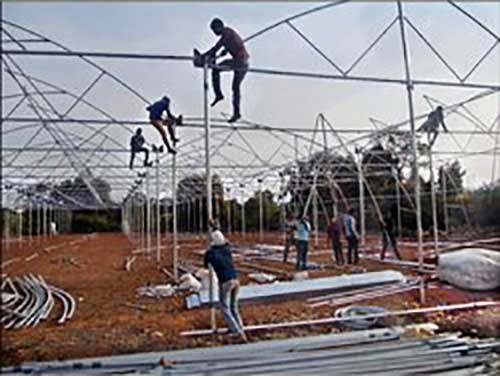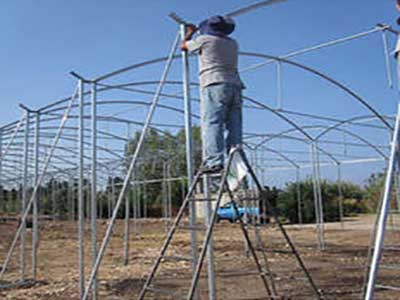Construction of commercial greenhouse and technical principles of its construction
The first step in building a greenhouse is to find the right place for it. Many things to improve the quality of the product along with reducing production costs, will lead to choosing the right place to build a greenhouse.
Definition of greenhouse?
A greenhouse is a limited space that has the ability to control the environmental conditions suitable for the growth of plants from different areas during different seasons of the year. According to this definition, one of the functions of a greenhouse is to provide the necessary environmental conditions for a certain product. Greenhouses are divided into fixed and mobile types according to the type of building materials used in them. Fixed greenhouses are greenhouses in which the building materials used are made of durable and durable materials. So you have to use them for years.
Build a commercial greenhouse with the highest efficiency
The first step in building a commercial greenhouse is to find the right place to build it. The planned programs for increasing the quantity and quality of the product along with reducing the production costs depend on choosing the right place to build the greenhouse. Choosing the best possible place to build a greenhouse or greenhouse complexes is one of the most important issues for decision making, for which different dimensions must be considered. This process is usually influenced by two categories of factors as follows:
1- Physical factors such as climatic suitability, water condition, soil condition and topography as well as hydrological condition of the region.
2 - Infrastructural factors such as available facilities, marketing, environmental status of the region.
The next step is to select the appropriate greenhouse structure and environmental control devices. At present, part (about 20%) of the greenhouse structures in the country, which are dedicated to growing vegetables and fruits, fruits, flowers and ornamental plants, are wooden and the rest are mainly metal structures with polyethylene plastic cover. Which do not have technically appropriate technologies and therefore can not control the environmental factors affecting production, so that these structures create many management challenges during production and usually their productivity is low. On the other hand, greenhouse devices play the role of controlling the environmental conditions inside the greenhouse. These devices include ventilation, heating, cooling, supplementary lighting, irrigation and drainage systems and other necessary devices.
The last step is production inputs, production management and marketing of produced products, which are among the factors affecting greenhouse cultivation. These factors include production inputs (seeds, pesticides, fertilizers, water, energy, etc.), technical knowledge among farmers, planting media, plant nutrition, pruning, planting time, pests and diseases of greenhouse plants, planning And irrigation systems, harvesting and post-harvest, consumer market and selling price of the product, production risk, training of greenhouse owners and providing consulting and engineering services required by the greenhouse.

Technical cases before building a greenhouse
For the location of greenhouses
The greenhouse skeleton creates shadows and varies according to the angle of radiation of these shadows. The need to pay attention to this is especially important in winter production, because small changes in the percentage of light reaching the plants can play a significant role in the quantity and quality of production. The position of the greenhouse should be such that it receives the maximum amount of light. The direction of the greenhouse depends on the geographical location as well as the climatic conditions (for strong winds) in the region.If the area is windy, to create less resistance, the greenhouse should be built in the direction of the prevailing wind. At latitudes less than 40 degrees north (as in all parts of Iran), the north-south direction is suitable for greenhouse construction. Construction of greenhouses in east-west direction in latitudes more than 40 degrees north is recommended for maximum sunlight and less shading of greenhouse structures (gutters) in winter.Gutter shading in these areas may cause uneven growth of some plants, and for this reason, this greenhouse arrangement in these areas is superior to the north-south arrangement in terms of the amount of light received in winter. The difference in sunlight consumption of greenhouses in east-west and north-south directions has been determined and reported by about 16%. The difference in sunlight reception, in addition to the geographical direction, also depends on the geometric shape of the greenhouse (greenhouse roof shape, greenhouse opening width, greenhouse height, etc.).
Deciduous trees such as maple and oak can effectively reduce the intense summer afternoon light by providing shade. Of course, it should be noted that the trees do not have shade on the greenhouse in the morning. These trees allow enough light to reach the greenhouse in winter; Because they lose their leaves in autumn.
| It is better that the length of the greenhouses is perpendicular to the direction of the prevailing wind in the area. (Due to the possibility of further strengthening the structure and the use of proper ventilation in the greenhouse). |

Latitude
Greenhouses at latitudes below 40 degrees north should be built along the north-south to make the most of winter light. For this reason, considering that Iran is located in the range of 27.5 to 39 degrees north, the construction of greenhouses in the country should be in the north-south direction.
Airflow in the greenhouse
Air circulation in the greenhouse is essential. When a plant is exposed to fresh air outside the greenhouse, fresh air is supplied near the leaves and the plant can return oxygen and use fresh carbon dioxide. Airflow also helps keep relative humidity low and temperature control in the greenhouse. Commercial greenhouses depend on all of the above requirements and even more.In a commercial greenhouse, the main goal is profitability; To achieve this goal, the greenhouse must be efficient in terms of providing the desired environmental conditions. Greenhouse light and temperature must be strictly controlled. Toxic gases and dust in the greenhouse can also be a serious problem. These gases include carbon monoxide, nitrogen oxide, and nitrogen dioxide; Which may be emitted by heating devices.
The best place to build a greenhouse
One of the first decisions to be made is to build the greenhouse as a separate unit, in contact with existing buildings or as part of new buildings. Connected greenhouses usually have lower construction and heating costs and are easier to access, but the plants receive less light. Connected greenhouses should be built facing south. An independent greenhouse can be built away from existing buildings.Plants in such a greenhouse receive sunlight from all directions. These greenhouses are very expensive in terms of construction and heating system, and they require huge costs for water and electricity lines. A greenhouse can be built in any size, but the smallest greenhouse that can be considered is about 200 square feet (18.4 square meters). Smaller greenhouses are relatively expensive in terms of construction and performance.
Issues to consider when building a greenhouse include:
* Access to transportation routes, which is minimized by constructing as close as possible to the main roads.
* Type of fuel used in the greenhouse; In areas where access to natural gas is possible, this can be used
Cheap fuel greatly reduced the cost of winter production.
* Access to water resources of appropriate quality and quantity.
* Environmental effects; Where there is constantly unfavorable weather, heavy rains, shadows from the northern slopes
High mountains or towering trees are not suitable for greenhouses. Light intensity is one of the determining factors.
* The type of product that is included in the production program; Considering that the tendencies are towards the specific production of products and the production agenda is determined after the initial study of the domestic and foreign markets. Before construction, they must first determine what products to produce. Then the decision is made to build a greenhouse in the region and a suitable climate for that product.
* Considering the laws related to the land of urban areas and the construction and operation of greenhouses and….
* The construction site should be as flat as possible, because if it is uneven and sloping, creating a large greenhouse will be associated with many problems and costs for leveling.
Examples of white construction projects in the country

